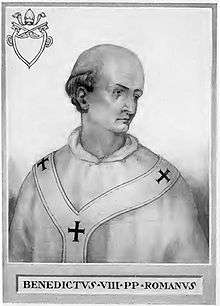Pope Benedict VIII
| Pope Benedict VIII | |
|---|---|
 | |
| Papacy began | 18 May 1012 |
| Papacy ended | 9 April 1024 |
| Predecessor | Sergius IV |
| Successor | John XIX |
| Personal details | |
| Birth name | Theophylactus |
| Born | ca. 980 |
| Died |
9 April 1024 Rome, Papal States, Holy Roman Empire |
| Other popes named Benedict | |
Pope Benedict VIII (Latin: Benedictus VIII; ca. 980[1] – 9 April 1024) reigned from 18 May 1012 to his death in 1024. He was born Theophylactus to the noble family of the counts of Tusculum (son of Gregory, Count of Tusculum, and brother of future Pope John XIX), descended from Theophylact, Count of Tusculum, like his predecessor Pope Benedict VI (973–974).
Life
Benedict VIII was opposed by an antipope, Gregory VI, who compelled him to flee Rome.[2] He was restored by Henry II of Germany, whom he crowned Holy Roman Emperor on 14 February 1014. He remained on good terms with Henry for his entire pontificate.[3] In Benedict VIII's pontificate the Saracens renewed their attacks on the southern coasts of Italy. They effected a settlement in Sardinia and sacked Pisa.[4] The Normans also then began to settle in Italy. The Pope promoted peace in Italy by allying himself with the Normans, orchestrating the defeat of the Saracens in Sardinia[5] and subjugating the Crescentii. In 1022, he held a synod at Pavia with the Emperor to restrain simony and incontinence of the clergy.[6] The reformation sponsored by Cluny Abbey was supported by him, and he was a friend of its abbot, St. Odilo.
In 1020, Benedict VIII travelled to Germany to confer with Henry II about the renewed Byzantine menace in the Mezzogiorno. Arriving at Bamberg at Eastertide, he consecrated the new cathedral there, obtained a charter from Henry II confirming the donations of Charlemagne and Otto the Great, and visited the monastery of Fulda.[7]
To further the interest of peace, he encouraged the Truce of God.[8]
He convinced the Emperor to lead an expedition into the south of Italy and subordinate his vassals who had defected to Greek authority.
Family tree
| Theophylact I, Count of Tusculum 864–924 | Theodora | ||||||||||||||||||||||||||||||||
| Hugh of Italy 887-924-948 (also married Marozia) | Alberic I of Spoleto d. 925 | Marozia 890–937 | Pope Sergius III 904–911 | ||||||||||||||||||||||||||||||
| Alda of Vienne | Alberic II of Spoleto 905–954 | David or Deodatus | Pope John XI 931–935 | ||||||||||||||||||||||||||||||
| Gregory I, Count of Tusculum | Pope John XII 955–964 | Pope Benedict VII 974–983 | |||||||||||||||||||||||||||||||
| Pope Benedict VIII Pope 1012–1024 | Alberic III, Count of Tusculum d. 1044 | Pope John XIX Pope 1024–1032 | |||||||||||||||||||||||||||||||
| Peter, Duke of the Romans | Gaius | Octavianus | Pope Benedict IX 1012–1055 | ||||||||||||||||||||||||||||||
References
- ↑ Cardinals of the Holy Roman Church
- ↑ Mosheim, Johann Lorenz; Murdock, James (1832). Institutes of Ecclesiastical History. A. H. Maltby. pp. 181–182.
- ↑ Lasko, Peter (1994). Ars Sacra: 800–1200. Yale University Press. p. 111. ISBN 0300060483.
- ↑ Gregorovius, Ferdinand; Hamilton, Annie (2010). History of the City of Rome in the Middle Ages. Cambridge University Press. p. 25.
- ↑ Collins, Roger (2012). Caliphs and Kings: Spain 796–1031. Blackwell Publishing. p. 201. ISBN 9780631181842.
- ↑ Walker, Williston (1921). A History of the Christian Church. Charles Scribner's Sons. p. 218.
- ↑ Ottosen, Knud (2008). The Responsories and Versicles of the Latin Office of the Dead. Books on Demand. p. 263.
- ↑ Mann, Horace. "Pope Benedict VIII." The Catholic Encyclopedia. Vol. 2. New York: Robert Appleton Company, 1907. 8 Sept. 2014
| Catholic Church titles | ||
|---|---|---|
| Preceded by Sergius IV |
Pope 1012–24 |
Succeeded by John XIX |

